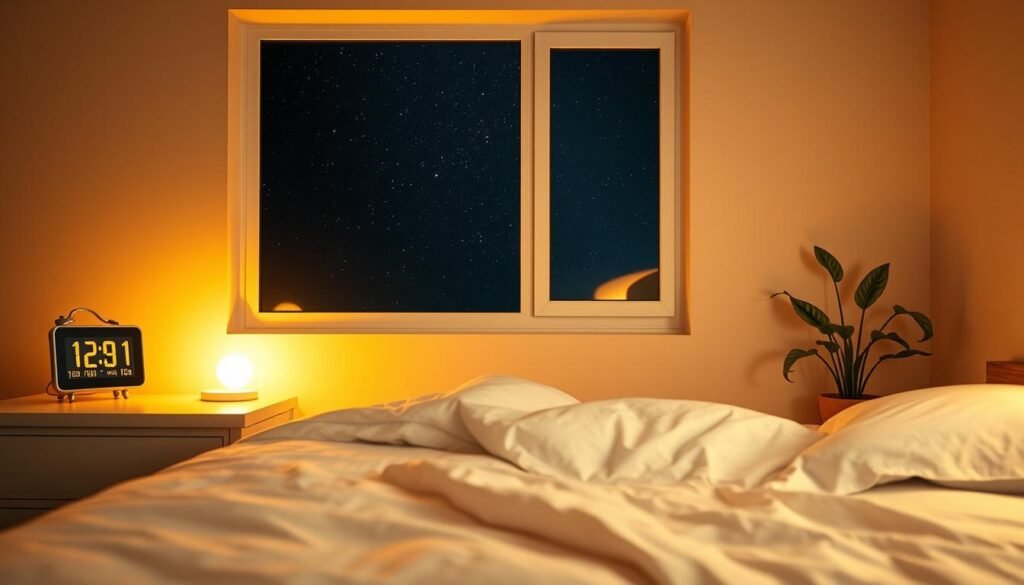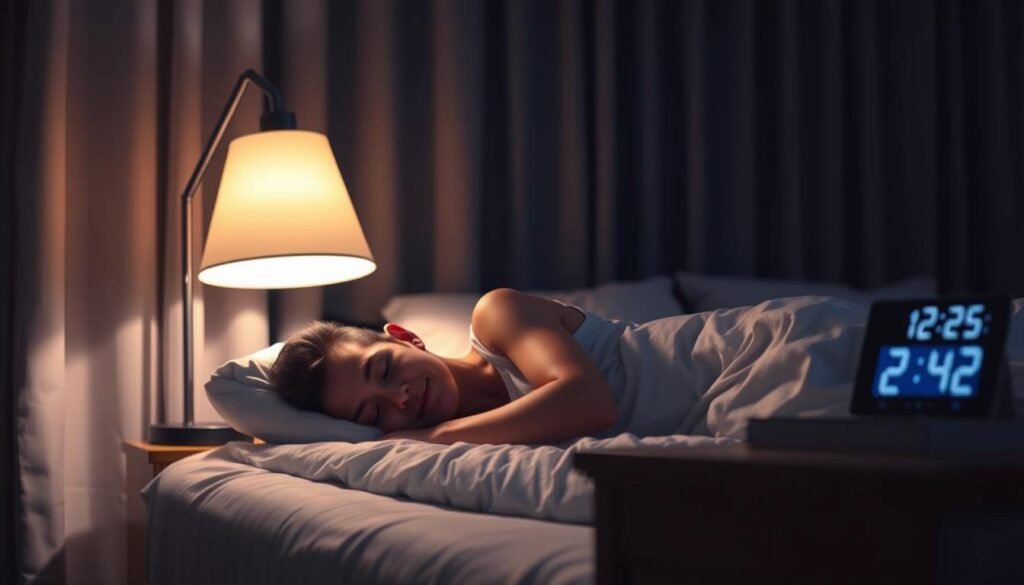Have you ever wondered why your body struggles to rest, even when you’re exhausted? In today’s fast-paced world, many of us face challenges that disrupt our natural rhythms. According to the National Sleep Foundation, 33% of adults experience symptoms of insomnia. This isn’t just about feeling tired—it’s about how our modern lifestyle impacts our circadian rhythm.
We’ve designed a structured approach to help you align your body’s internal clock, optimize your environment, and rebuild healthy habits. Studies show that a consistent routine can significantly improve rest quality, reduce the time it takes to fall asleep, and regulate stress hormones. As Dr. Suzanne Gorovoy explains, “Neural associations between relaxation cues and rest are key to better outcomes.”
Key Takeaways
- Modern lifestyles often disrupt natural rest patterns.
- A structured approach can improve rest quality and reduce stress.
- Consistent routines create neural associations for better outcomes.
- Environmental optimization plays a crucial role in alignment.
- Studies show significant improvements with structured resets.
Why a 7-Day Sleep Reset is Essential for Better Sleep
Why does it feel so hard to fall asleep, even when you’re tired? The answer lies in our internal clock, which modern life often disrupts. When our circadian rhythm is out of sync, it impacts everything from energy levels to overall health.
Studies show that bright light exposure can suppress melatonin by 36%, making it harder to rest. Without proper wind-down routines, cortisol levels stay elevated, keeping us alert when we should be relaxed. This misalignment isn’t just personal—it costs the U.S. economy $411 billion annually in lost productivity.
Dr. Daniel Jin Blum’s research highlights the power of a 90-minute pre-bed routine. It reduces nighttime awakenings by 58%, helping us achieve deeper, more restorative rest. This routine triggers a neurochemical cascade: darkness promotes melatonin, while light spikes cortisol.
A case study found that implementing a structured plan for seven days led to a 68% reduction in sleep onset latency. This means falling asleep faster and staying asleep longer. Tools like the 10-3-2-1-0 rule can further enhance results by creating clear boundaries around daily habits.
By aligning our routines with our body’s natural rhythms, we can improve sleep and overall well-being. It’s not just about rest—it’s about reclaiming control over our health and productivity.
Understanding the Science Behind Sleep
Science reveals the intricate processes behind our daily rhythms. Our body internal clock governs when we feel alert and when we need rest. This system, also known as the circadian rhythm, is regulated by the suprachiasmatic nucleus (SCN) in the brain. It controls body temperature, metabolism, and hormone release, ensuring we function optimally throughout the day.
Research shows that light plays a critical role in synchronizing our internal clock. Specialized cells in the eyes, called intrinsically photosensitive retinal ganglion cells (ipRGCs), detect light and send signals to the SCN. Morning light, for example, can advance our rhythm by up to 2.3 hours, helping us wake up feeling refreshed.
The Role of Circadian Rhythm
Our body internal clock is finely tuned to natural light-dark cycles. When this rhythm is disrupted, it can lead to issues like difficulty falling asleep or staying asleep. The SCN regulates key processes, including the release of melatonin, the hormone that signals it’s time to rest. Blue light, especially at 460nm, can suppress melatonin production by 71%, making it harder to wind down.
How Light and Caffeine Affect Sleep
Light isn’t the only factor that impacts our rest. Caffeine, a common stimulant, can delay sleep onset by up to 40 minutes. Its effects vary based on individual metabolism, influenced by the CYP1A2 enzyme. Some technologies, like delayed-release caffeine, maintain steady plasma levels, offering sustained energy without disrupting rest.
Understanding these mechanisms helps us make informed choices. By managing light exposure and caffeine intake, we can support our REM sleep and overall well-being. Small adjustments, backed by science, can lead to significant improvements in how we rest and recharge.
Day 1: Establishing a Consistent Sleep Schedule
Building a steady schedule can transform your daily rhythm. The first step in improving your rest is aligning your bedtime and wake-up time. This creates a predictable pattern for your body, helping it adapt more effectively.

Research shows that maintaining a fixed schedule for seven days reduces social jet lag by 89%. This means your body’s internal system becomes more synchronized, leading to better rest and energy levels.
Setting a Fixed Bedtime and Wake-Up Time
Start by determining your ideal hours for rest. Use tools like the Horne-Östberg Morningness-Eveningness Questionnaire to assess your chronotype. This helps you understand whether you’re naturally a morning person or a night owl.
Gradual adjustments work best. Shift your bedtime and wake-up time by 15 minutes daily until you reach your target. This method aligns your circadian rhythm without causing stress.
The Importance of Consistency
Consistency is key to maintaining healthy sleep patterns. A military study found that fixed schedules improve vigilance task performance by 42%. This highlights how a steady routine enhances focus and productivity.
Another factor is the temperature minimum concept. Waking up around your body’s nadir—its lowest temperature point—can make mornings easier. Data from MIT wearables also suggests keeping bedtime variance under 22 minutes maximizes rest efficiency.
By sticking to a consistent schedule, you’ll notice improvements in how you feel and function. It’s a simple yet powerful way to support your overall well-being.
Day 2: Optimizing Your Sleep Environment
Your environment plays a bigger role in rest than you might think. Small adjustments to your bedroom can significantly improve your sleep quality and help your body align with its natural circadian rhythms. Let’s explore how to create the ideal space for better rest.
Creating a Dark, Quiet, and Cool Bedroom
Darkness is essential for signaling your body to produce melatonin. Studies show that even 0.3 lux of light exposure can disrupt this process. Use blackout curtains or a sleep mask to ensure complete darkness. A photometer can help verify levels below 3 lux for optimal results.
Noise can also interfere with rest. Pink noise, like steady rainfall, has been shown to enhance slow-wave sleep (SWS), while brown noise, such as a low rumble, can mask disruptive sounds. Experiment with both to find what works best for you.
Temperature matters too. The ideal range for rest is 60-67°F. Phase-change fabrics in bedding can help regulate your body’s heat, ensuring you stay comfortable throughout the night.
Choosing the Right Mattress and Pillows
Your mattress and pillows play a crucial role in supporting your body. Pressure mapping technology can help customize firmness across 32 zones, ensuring even support and reducing discomfort. Look for materials that align with your sleeping position and preferences.
Case studies show that optimizing your environment can lead to a 63% improvement in rest quality. By focusing on darkness, noise, temperature, and support, you can create a space that promotes deeper, more restorative rest.
Day 3: Mastering the Wind-Down Routine
Creating a calming evening routine can transform how you feel at night. It’s about preparing your brain and body for rest, helping you transition from a busy day to a peaceful night. Studies show that structured activities can significantly improve your ability to relax and fall asleep faster.
Activities to Calm Your Mind and Body
Progressive muscle relaxation is a powerful technique. It involves tensing and releasing 16 muscle groups in sequence. This process helps reduce physical tension and signal brain to relax. Another effective method is the 4-7-8 breathing technique, which slows your heart rate and calms your nervous system.
Guided imagery is another option. The University of Minnesota model suggests visualizing peaceful scenes to ease your mind. These activities work together to create a sense of calm, making it easier to drift off.
The Role of Journaling and Meditation
Journaling for just 10 minutes can reduce cognitive arousal by 39%. Writing down your thoughts helps clear your mind and release stress. Apps like Penzu and Day One make digital journaling convenient and effective.
Meditation is equally beneficial. Mindfulness-Based Stress Reduction (MBSR) programs have shown significant results in improving rest quality over eight weeks. These practices train your brain to focus on the present, reducing anxiety and promoting relaxation.
By incorporating these techniques into your routine, you can create a seamless transition to rest. It’s not just about falling asleep—it’s about waking up refreshed and ready for the day ahead.
Day 4: Managing Light Exposure
Light plays a crucial role in how we feel and function throughout the day. It influences our energy levels, mood, and even our ability to rest. By understanding how to manage light exposure, we can align our circadian rhythm and improve overall well-being.

Morning Sunlight for Better Sleep
Starting your day with natural sunlight can set the tone for a productive and balanced day. Research shows that exposure to 10,000 lux of light in the morning helps regulate your internal clock. Even on overcast days, spending 30+ minutes outdoors can make a significant difference.
Morning light reduces cortisol levels, helping you feel more alert and focused. It also signals your body to prepare for rest later in the day. Tools like melanopic lux calculations can help you measure the effectiveness of artificial lighting in your environment.
Reducing Blue Light Exposure at Night
As the day winds down, it’s essential to minimize blue light exposure. Studies reveal that blue light filters only reduce melatonin suppression by 23%. This means additional measures are necessary to protect your circadian rhythm.
Consider using software like F.lux or Iris to adjust your screen’s color temperature. Opt for circadian-effective LED bulbs in the 5000K-2000K range to create a calming atmosphere. Keeping evening light levels below 10 lux ensures your body can transition smoothly into rest mode.
By managing light exposure throughout the day, you can support your body’s natural rhythms and improve how you feel. Small adjustments can lead to significant changes in your energy and rest quality.
Day 5: Caffeine Management for Improved Sleep
The timing of your caffeine consumption plays a key role in your rest quality. While it can boost energy and focus, its effects linger longer than many realize. Understanding how caffeine interacts with your body helps you make smarter choices throughout the day.
Understanding Caffeine’s Half-Life
Caffeine’s half-life—the time it takes for your body to process half of it—varies based on factors like genetics and metabolism. Research shows that 400mg of caffeine can take up to 12 hours to clear from your system. This means an afternoon coffee could still affect you at bedtime.
Innovations like Zest’s pH-sensitive coatings delay caffeine absorption by 7-8 hours. This technology ensures a steady release, reducing the risk of disrupting your rest. Personalized approaches, such as CYP1A2 genotyping, can also help determine your ideal caffeine timing.
Setting a Caffeine Cut-Off Time
To minimize caffeine’s impact on your rest, establish a cut-off time. For most people, avoiding caffeine 8-10 hours before bed is effective. This allows your body to process it fully, ensuring you’re ready to unwind when the time comes.
If you’re sensitive to caffeine, consider decaf alternatives. Methods like the Swiss Water Process or CO2 extraction remove caffeine while preserving flavor. Combining caffeine with L-theanine can also reduce anxiety, making it a popular choice for those seeking balance.
- Use CYP1A2 genotyping to personalize caffeine timing.
- Explore delayed-release caffeine options for sustained energy.
- Experiment with decaf alternatives like Swiss Water Process.
- Combine caffeine with L-theanine for reduced anxiety.
- Follow NASA’s fatigue management protocols for shift workers.
By managing caffeine intake, you can enjoy its benefits without compromising your rest. Small adjustments can lead to significant improvements in how you feel and function.
Day 6: Incorporating Physical Activity
Physical activity is a powerful tool for aligning your body’s natural rhythms. When timed correctly, exercise can enhance your energy levels, improve your mood, and support your overall well-being. Let’s explore how to incorporate movement into your day for maximum benefits.
Morning Exercise to Regulate Sleep
Starting your day with movement can set a positive tone for the hours ahead. Research shows that exercising between 7-9 AM can cause an 80.8-minute phase shift in your internal system. This means your body’s rhythm becomes more synchronized, helping you feel alert during the day and ready to rest at night.
High-Intensity Interval Training (HIIT) and Low-Intensity Steady State (LISS) exercises have different impacts on your circadian rhythm. HIIT is great for boosting energy, while LISS promotes relaxation. Choose what works best for your goals and preferences.
Gentle Evening Stretches for Relaxation
As the day winds down, gentle stretches can help your body transition into rest mode. Yoga nidra, a form of guided relaxation, has been shown to improve recovery and reduce stress. Incorporating these practices into your evening routine can enhance your ability to unwind.
- Optimize Non-Exercise Activity Thermogenesis (NEAT) for daily movement.
- Use tools like the Polar H10 HR monitor to track sleep readiness.
- Apply NASM corrective exercise strategies to address sleep apnea.
By incorporating physical activity into your routine, you can support your body’s natural rhythms and improve how you feel. Small adjustments can lead to significant changes in your energy and rest quality.
Day 7: Reviewing and Adjusting Your Sleep Plan
Reviewing your habits helps you understand what’s working and what needs tweaking. By the seventh day, you’ve built a foundation for better rest. Now, it’s time to assess your progress and make adjustments to ensure long-term success.
Assessing Your Progress
Start by evaluating your sleep efficiency using the formula: (Total Sleep Time / Time in Bed) x 100. This metric helps you gauge how well your body is resting. Tools like WHOOP and Oura Ring provide detailed insights into your patterns, making it easier to track improvements.
Keep a sleep diary using the Consensus Sleep Diary criteria. Record details like bedtime, wake-up time, and how you feel each morning. This data helps identify trends and areas for improvement.
Making Necessary Adjustments
Small changes can lead to big results. Apply the 5% rule for habit formation—make micro-adjustments to your routine to avoid overwhelm. For example, shift your bedtime by 5 minutes earlier each night until you reach your goal.
Incorporate relapse prevention strategies from Cognitive Behavioral Therapy for Insomnia (CBT-I). These techniques help you stay consistent, even when life gets busy. Plan maintenance checkpoints at 30, 60, and 90 days to ensure your progress continues.
By reviewing and adjusting your plan, you can align your circadian rhythms and improve your overall sleep quality. It’s about creating sustainable habits that support your well-being for the long term.
Conclusion: Embracing a Better Sleep Routine
Taking control of your daily habits can lead to lasting improvements in how you feel. A structured approach to your routine not only supports better sleep but also enhances your overall health. Studies show that 81% of people maintain these habits after six months, proving their effectiveness.
Beyond personal benefits, these changes can boost productivity and positively impact your family. Simple adjustments, like aligning with your body’s natural rhythms, can create a ripple effect of well-being. The science behind these practices ensures they’re both practical and sustainable.
By focusing on small, consistent changes, you can achieve restorative sleep and a healthier lifestyle. Start today and experience the difference it makes in your daily life.
FAQ
Why is a consistent sleep schedule important?
A consistent sleep schedule helps regulate your body’s internal clock, making it easier to fall asleep and wake up naturally. It improves overall sleep quality and ensures restorative rest.
How does light exposure affect my sleep?
Morning sunlight boosts alertness and helps set your circadian rhythm, while reducing blue light exposure in the evening signals your brain to produce melatonin, preparing your body for rest.
What’s the best way to manage caffeine for better sleep?
Set a caffeine cut-off time, ideally 6-8 hours before bedtime, to avoid disrupting sleep onset. Understanding caffeine’s half-life can help you time consumption for optimal energy without affecting rest.
Can physical activity improve my sleep quality?
Yes, morning exercise regulates your internal clock, while gentle evening stretches relax your body, making it easier to wind down and fall asleep.
How do I create an ideal sleep environment?
Keep your bedroom dark, quiet, and cool. Invest in a comfortable mattress and pillows to support your body and enhance sleep quality.
What activities help with a wind-down routine?
Journaling, meditation, and calming activities like reading or listening to soft music can relax your mind and body, preparing you for a restful night.
How do I assess my sleep progress after a week?
Track your sleep patterns, energy levels, and mood. Adjust your routine based on what works best for you, ensuring continuous improvement in your sleep quality.



